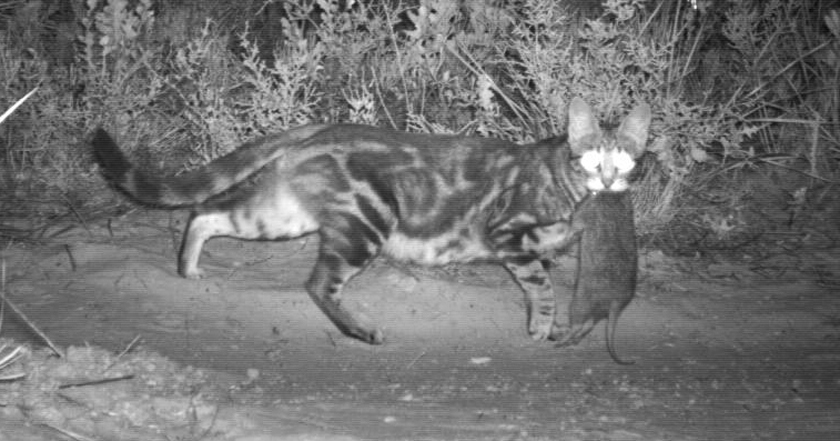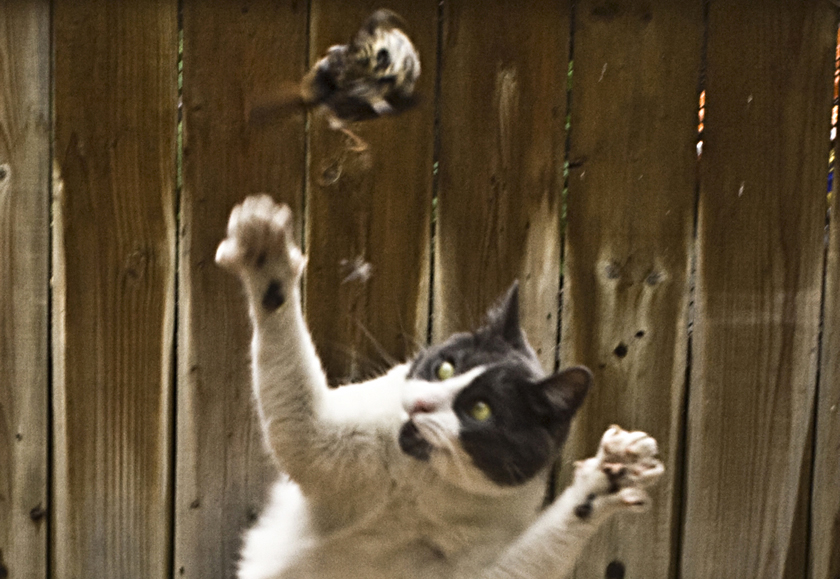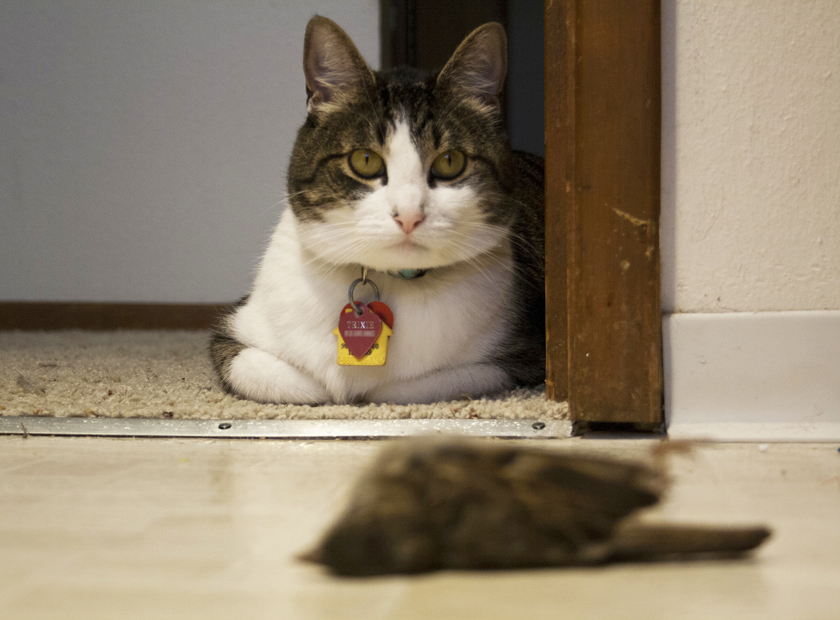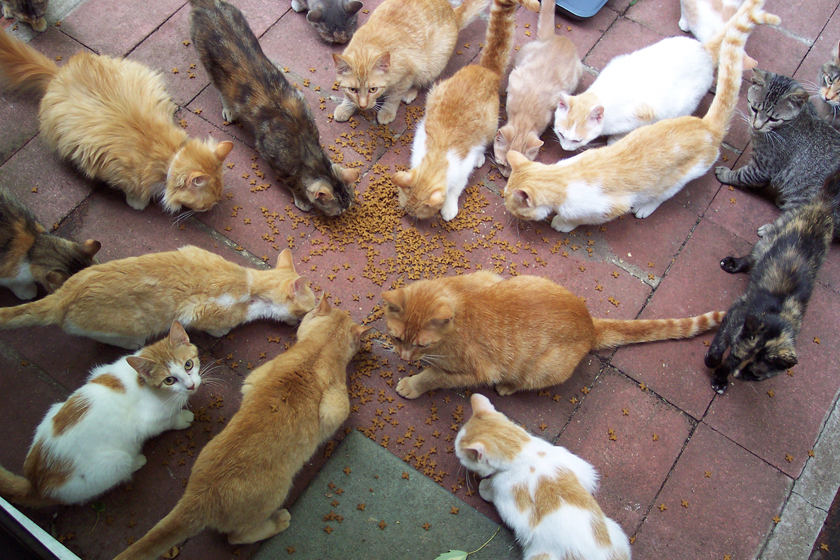The Global Cat Wars
Australia’s decision to kill 2 million feral cats is the latest event in an epic battle among cat lovers, bird lovers, and even celebrities over cats and their impact on wildlife.
By Vicki Croke
The debate over outdoor cats often pits animal lovers against animal lovers.
And it concerns outdoor cats (those pet cats who spend part of their time outside, and the strays or feral cats who live there full time) and the effect of their predatory behavior on wildlife. In the United States alone, federal researchers say, cats kill 2.4 billion birds and 12.3 billion mammals each year.
Vicki spoke with Here&Now’s Robin Young about feral cats and the death of Zimbabwe’s Cecil the lion:
The battles over this issue are epic and seemingly endless, with cat lovers, bird lovers, conservationists, celebrities, and homeowners disagreeing about numbers and solutions. How many feral cats are there? How many animals are killed by them? Is it best to care for feral cats by having volunteers trap them, neuter and vaccinate and release them, or to trap them and take them away? Where feral cats come into conflict with endangered birds, is one life worth more than another?
In Australia, the government decided the answer to that last question was a resounding yes. Just this month, it announced a plan to kill two million cats over the next five years. Speaking to Australian radio, the country’s first threatened-species commissioner said the government was “declaring war on feral cats,” and would shoot, poison, and bait them in its large scale effort. “We don’t hate cats,” Commissioner Gregory Andrews said, “We just can’t tolerate the damage that they’re doing anymore to our wildlife.” It has been reported that cats are at least partly to blame for 28 of 29 mammal extinctions there and that 20 million Australian cats kill 75 million animals every day.

Feral cat with a bandicoot. Courtesy of Western Australia Department of Environment and Conservation.
Australia may be making the latest headlines on the issue, but the country is not alone. Heated and sometimes physically violent disagreements over feral cats are taking place in the United States, Canada, and the United Kingdom, among others.
Anchoring much of the discussion here in the U.S. is a study published in the journal Nature Communications in 2013. Scaling up local surveys to create a national picture of predation, the Smithsonian Conservation Biology Institute and the U.S. Fish and Wildlife Service made that estimate of billions of birds and mammals killed each year here by domestic cats (ferals and pets on the loose).
“Socialized or unsocialized, cats are predators and we should accept that as a basic truth.” –Carter Luke, MSPCA.
“Cats are a huge problem for birds,” says Grant Sizemore, director of invasive species programs at American Bird Conservancy (or ABC). “They are actually the Number One source of direct human-caused mortality for birds both in the United States and Canada.”
While the so-called cat and bird camps can seem completely polarized, Carter Luke, the head of the Massachusetts Society for the Prevention of Cruelty to Animals, thinks there is a middle ground, though, as he says, “I’m practical enough to know that there are people who are absolutely rabid on both the avian and feline sides of the fence. No doubt about it.”
Unlike Australia, the issue is being dealt with in the United States largely on a community-by-community basis.
The first part of the issue involves keeping owned cats indoors.

Carter Luke (along with most members of the big animal welfare groups) believes owned cats should live indoors. Photo: Andrew Currie/Flickr.
Luke (along with most members of the big animal welfare groups) believes owned cats should live indoors—he says it’s healthier for them and for wildlife. And on that Sizemore agrees. He runs an educational program at ABC focused on educating people to keep cats indoors.
It’s when the talk turns to feral cats that, as Sizemore puts it, “People tend to butt heads a little bit.” Yes, feral cats are where sparks fly. And much of the complex debate hinges on two very different strategies for dealing with them—one is for communities or individual volunteers to care for feral cats—trapping them temporarily in order to vaccinate and sterilize them (often called TNR for trap, neuter, return). Sometimes ongoing care, including feeding, is provided. And the other strategy is to remove free-roaming cats from the equation by confining, or even killing them, as Australia is doing.
“Outdoor cats are actually listed by the International Union for the Conservation of Nature to be among the world’s worst invasive species. Like other invasives—pythons and kudzu—they disrupt natural ecosystems.” –Grant Sizemore, American Bird Conservancy.
While Carter Luke and the MSPCA support TNR programs, Sizemore is not on board. He mentions that the initials TNR could stand for “Trap, Neuter, and Re-abandon.” Sizemore says, “The scientific evidence overwhelmingly indicates that TNR simply does not effectively reduce feral cat populations.” He advocates two other options: “Removal is far more efficient and practical, and one simple fix for TNR is actually enclosing the feral cat colony.”
TNR supporters disagree, saying that their method is actually more effective. As the Huffington Post reported:
When members of an animal population are killed off, the animals missed by the cull tend to reproduce at a higher rate to restore the population, according to Alley Cat Allies, a U.S. feral cat advocacy group. Additionally, in a phenomenon known as the “vacuum effect,” neighboring populations expand and move into the newly vacant habitat.
However, if the animals are spayed or neutered and returned to their original area, there is no immediate vacancy. The population is stabilized, and the neutered cats will eventually die off. Alley Cat Allies cites two studies that suggest this method—known as Trap-Neuter-Return—causes feral cat populations to decrease over time.
Luke says that the MSPCA has taken a wide view of how to curb feral cat populations. Something like a public health model to define “at risk” areas. Over the past 10 years, his group, which operates “open admission” animal shelters, scrutinized hot-spot communities. Which zip codes within Massachusetts seemed to be dropping the most cats off? Could focusing education and low-cost spay and neutering in those areas result in an overall reduction of unwanted and stray cats?
Luke says if the surrender rates at the MSPCA have anything to say about it, the answer is yes. The numbers of cats coming into the shelter in June (the peak kitten month) “has dropped by close to 75 percent.” Over the last several years, the animal welfare group says its June admissions have gone from the thousands to the hundreds.
“Our numbers are dropping as are the numbers of other shelters in the Northeast,” he says. “It’s clear in the Northeast that we are seeing reductions in the outdoor cat population—that means that there is a reduction in predation, so I think things are getting better.”
But it sure is hard to count cats. Especially homeless cats. The Humane Society of the United States estimates that there are about 50 million feral cats in the U.S.
Luke has crunched a lot of cat numbers and he sees a complex and nuanced picture of cat care and opinions about cats. Or rather, he sees a lot of pictures that vary by community, by state, and by region.
About two-thirds of the free-roaming cats in the Northeast, he says, “are what we would call ‘socialized’—at some point in time in their lives, they had close contact with people.” But, Luke says, “Socialized or unsocialized, cats are predators and we should accept that as a basic truth.”
“I’ve always believed that the animal welfare and environmental groups have so many things in common. Let’s work toward a solution together.” –Carter Luke, MSPCA.
Sizemore has a more urgent view and says, “Outdoor cats are actually listed by the International Union for the Conservation of Nature to be among the world’s worst invasive species. Like other invasives—pythons and kudzu—they disrupt natural ecosystems.”
The MSPCA does not directly run TNR programs, but Luke says the organization does support them. In the case of cats preying on populations of threatened or endangered bird species, Luke says, “those birds require protection,” and that cats need to be removed from the area.
Jones Beach on Long Island, NY, is a case in point. Piping plovers nest there, and ABC, would like to see a nearby feral cat colony removed, while the cat advocates say they are keeping the birds safe by keeping the cats fed.
The battle between animal lovers is a sad one to Luke. “I’ve always believed that the animal welfare and environmental groups have so many things in common,” he says. “Let’s work toward a solution together.”
But the divide between those who think cats belong outdoors and those who don’t can be deep. How deep?
Well, this summer, a firefighter in Los Angeles was sentenced to six months in jail for beating a woman into unconsciousness who had been feeding stray cats in his neighborhood.
In 2013, a nature journalist, who normally wrote for Audubon Magazine, wrote a column for the Orlando Sentinel about feral cats, and in it, suggested that they might be euthanized with an over-the-counter-medication. That resulted in a firestorm—thousands of emails and social media posts and the writer was suspended, and then after an apology, reinstated at Audubon—which brought another wave of reaction.
Celebrities like Edie Falco (pro-TNR), Brigitte Bardot (against Australia’s decision to kill cats), and author Jonathan Franzen (outspoken and avid birder who included the feral cat issue in a novel) have all entered the fray.
And there have even been cases in which bird advocates have been charged and sometimes convicted of animal cruelty for shooting or poisoning cats.
Part of the most heated arguments center on the health issues for outdoor cats, who can transmit a number of diseases. In a March 21, 2014 column in the New York Times’s Sunday Review, Richard Conniff wrote:
Cats are three to four times more likely than dogs to carry rabies, according to the Centers for Disease Control and Prevention. They also share many other parasites or infectious microbes with humans, including roundworms, hookworms, giardia and campylobacter. When cats live outdoors it is almost impossible to predict what they will bring home next. In Massachusetts and New York, for instance, cats recently turned up infected with a worm normally found in raccoons. One owner pulled four of them, about six inches long, through her cat’s skin, “which isn’t the best idea,” says one of the Cornell University scientists who reported the cases.
Most insidiously, outdoor cats are the primary hosts of toxoplasmosis, which is estimated to infect almost 30 percent of all humans worldwide. Toxoplasmosis produces lifelong parasitic cysts in the brain, and though it is generally asymptomatic it has been linked to neurological impairments, depression, blindness and birth defects. Even in asymptomatic individuals, the infection is associated with significant loss of memory in later life, according to a study last month in the journal Brain, Behavior, and Immunity.
Carter Luke, along with most of those involved in this work, agree on one thing: the issue will continue to be debated for a long time to come.




11 Responses to “The Global Cat Wars”
I have watched cats prey on birds. They get real close. Then in a flash the bird flies away. The birds win most all the time. Same with mice.
This is true of nearly all predator-prey interactions.
The numbers they kill is still staggering.
I like cats …….. but you need to add salt.
That’s a very rude thing to say.
some wrong with a picture of a group of cats. idk. all i know is, kill them all. worthless specie. a possisum is probably a better pet to have.
Put down the people who dump cats in the bush. That would soon eradicate the problem.
The forum is a britgher place thanks to your posts. Thanks!
Luke is using surrender rates at MSPCA to support claims that his program is reducing feral cat numbers, without ever getting out there with trail cams and actually doing a scientific study to independently verify the cat numbers and prove that they are related to surrender rates. What I’ve seen happen is that cat fanatics are avoiding surrendering cats by keeping them in colonies in our parks, public spaces, and other peoples yards, beach areas, etc by feeding them. Sometimes they are neutered and sometimes not. Sometimes there are hundreds of cats in a feeding area and people simply are not surrendering them, because they would rather keep feeding them. The feeding areas become magnets for more cats. Fewer surrenders just means people are dumping cats at feeding areas, it isn’t a true data point for feral cat population counts. It also isn’t a measure of how much damage the cats are doing to the local native small mammals and birds. Well fed cats are still instinctively predatory and can still prey successfully on birds and small mammals, neutered or not.
TNR does not control population, it only shifts the burden to the public…… It’s a cruel practice for both the cats and the community…….
They’ve been killing nearly 2 million cats in the USA alone every year, that’s 5 times faster than what Australia hopes to accomplish, and still they haven’t put a dent in them in the USA. They are still breeding out of control at exponential rates. Morons are depending on slow and inefficient trapping methods that can never catch-up to cats’ breeding rates and the rates at which other morons let intact cats roam outdoors. But hunted to extinction works! Just ask the Passenger Pigeon. Oh wait. you can’t. :-)
Any non-native cat that is allowed to illegally hunt our native wildlife where I live then in turn gets hunted until dead. No delays, no excuses, no exceptions. That’s the very best way to keep these invasive species vermin from destroying any more native wildlife or spreading any more of their 3dozen+ deadly diseases to all other animals and humans. They had annihilated all the wildlife on my lands for 15 years, until on advice of the Sheriff I shot and buried every last one of hundreds of their vermin cats for them (as-is the legal right of every land-owner). Collared or not — for you must destroy ALL stray collared cats as well, they are the very source of every last feral cat. If you don’t destroy them too then you have done NOTHING to solve the feral cat problem. Guaranteed. All the cat-lickers by me told me for over a decade that all their “pet” cats were sterilized. But upon inspection during shooting and burying hundreds of them, NOT ONE of their cats was sterilized. Cat-advocates and cat-owners who let cats roam free are manipulative and deceptive liars — one and all.
Where cats have already learned to evade all trapping methods for trapping & drowning (and you aren’t confident with firearms or air-rifles (local ordinances permitting)), then inexpensive generic acetaminophen (overseas paracetamol) pain-relievers are a more species-specific vermin poison (though harmful to most reptiles, which won’t be dining on the cat-bait-foods that you’ll be using) — a method condoned by even Audubon, Smithsonian, and National Geographic today. Stray cats have been listed as “vermin” since the early 1900’s. (I learned this from a cat-licker. Thanks cat-lickers!) This is why it is even legal to use any and all vermin-poisons on them. For an even more species-specific vermin poison check into the toxicity of “Lilium” species of flowers too. Be certain the plant contains the word “Lilium” in the scientific-name (other plants with the word “Lily” in the common-name may be toxic to other species besides cats). Common N. American “Day Lilies” (Hemerocallis graminea) also work, they are the one exception to the rule that the name “Lilium” needs to be in the scientific name. Lilium species of flowers are 100% fatal to cats ONLY, even a bit of pollen on their fur that they lick-off will do. If they even drink a bit of water in which a bunch of Lilium flowers have been kept — that too is fatal, but totally harmless to all other species of animals (including dogs). Much safer for the environment and all other animals than the rat-poisons and antifreeze that cat-lickers have forced everyone into using on their cats. These plants when harvested and dried for year-round cat-eradication use is even better, as the unknown toxin is concentrated during the drying process (the blossoms and pollen being most toxic), and the dried plants are even more palatable to cats. An excellent mulch for anyone’s garden or a ground-up additive for any tins of food left lying around.
However, you really need to dispose of that cat safely and hygienically so that wildlife won’t die from the deadly diseases cats spread even after their death. Leaving ANY cat out in nature, alive OR dead, is no better than intentionally poisoning your native wildlife to death. I know this. I fed one of the hundreds of shot-dead cats on my lands to some wildlife under my care, those animals and their offspring that they had while under my care then died from some disease in that cat-meat. Cats truly are complete and total wastes-of-flesh. They can’t even be used to feed wildlife safely.
I don’t see anyone dumping cats where I live anymore. They don’t even adopt more than can be kept under lock & key 24/7/52. When driving through the area I don’t see even one cat on anyone’s doorsteps anymore. I always keep an eye-out to see if there are more free-roaming cats that will have to be shot. And if I’ll have to leave fish-oil trails on all the roadsides again, leading right to my IR surveillance system and laser-sighted rifle. The eradication of these vermin was so complete and effective that cats are non-existent from my area for SIX years now. Not seen nor heard a single one. So much for that cat-lickers’ oft-spewed and manipulative “vacuum effect” deception and lie too, eh?
Leaving ANY of their invasive species cats outside in my area means certain death for their cat, its further existence can be counted in hours. You’d think everyone else could learn from this simple lesson. The quickest way to solve an unwanted animal and irresponsible pet-owner problem is to let everyone know that you will quickly and humanely destroy every last one of their unwanted, uncared-for, or unsupervised animals for them. They either grow up fast or, far more plausible, dump their animals elsewhere to become someone else’s problem.
You just can’t be an enabler of criminally irresponsible spineless and heartless idiots — or they remain that way. (At least where you live, anyway.)
If there are not direct and immediate irreversible consequences to pet-owners’ criminally-negligent and criminally-irresponsible behaviors and values then they learn absolutely nothing.
Comments are closed.